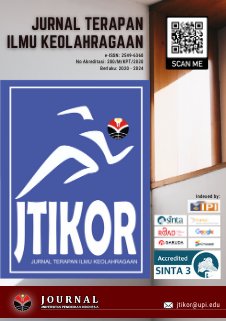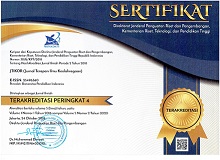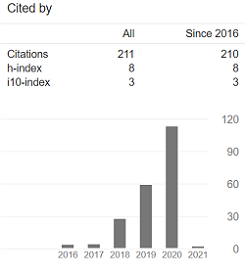Anthropometric, Biomotor, and Physiological Factors for Indonesian Fencing Athletes Talent Identification
Sari
Kata Kunci
Teks Lengkap:
PDFReferensi
Woods CT, Raynor AJ, Bruce L, McDonald Z, Robertson S. The application of a multi-dimensional assessment approach to talent identification in Australian football. J Sports Sci. 2016 Jul;34(14):1340–5.
Walker IJ, Nordin-Bates SM, Redding E. Talent identification and development in dance: A review of the literature. Vol. 11, Research in Dance Education. Routledge ; 2010. p. 167–91.
Enrique L, Francisco S, Enrique N, Oscar Martínez de Q, Raquel de A. Analysis of the Fencing Lunge Flight Phase in Epee. 12th Annu Congr ofthe ECSS. 2007;1(July):2007.
Roi GS, Bianchedi D. The science of fencing: Implications for performance and injury prevention. Vol. 38, Sports Medicine. Springer; 2008. p. 465–81.
Mohamed SA, Larion A. Effect of S.a.Q Training on Certain Physical Variables and Performance Level for Sabre Fencers. Ovidius Univ Ann Ser Phys Educ Sport Mov Heal. 2018;18(1):46–51.
Vaeyens R, Güllich A, Warr CR, Philippaerts R. Talent identification and promotion programmes of Olympic athletes. J Sports Sci. 2013;27(May 2013):1367–80.
Abbott A, Collins D, Abbott A, Collins D. Eliminating the dichotomy between theory and practice in talent identification and development : considering the role of psychology Eliminating the dichotomy between theory and practice in talent identification and development : considering the role of ps. 2007;(January 2015):37–41.
Durand-Bush N, Salmela JH. The development and maintenance of expert athletic performance: Perceptions of world and olympic champions. In: Journal of Applied Sport Psychology. 2002. p. 154–71.
Ward P, Hodges NJ, Starkes JL, Williams AM. The road to excellence: deliberate practice and the development of expertise. High Abil Stud. 2007 Dec;18(2):119–53.
Ochoa A, Gutiérrez G, Margain L, De Luna A. Determining anthropometry related with Fencing using social data mining. J Phys Educ Sport Manag. 2013 Aug;4(3):31–5.
Polman R, Bloomfleld J, Edwards A. Effects of SAQ training and small-sided games on neuromuscular functioning in untrained subjects. Int J Sports Physiol Perform. 2009 Dec;4(4):494–505.
Jovanovic M, Sporis G, Omrcen D, Fiorentini F. Effects of Speed, Agility, Quickness Training Method on Power Performance in Elite Soccer Players. J Strength Cond Res. 2011 May;25(5):1285–92.
Auili A, Tancredi V, Triossi T, De Danctis D, Padua E, D’arcangelo G, et al. Perfrmance anaylsis in Saber. J Strength Cond Res. 2013;27(3):624–30.
Zampagni ML, Casino D, Benelli P, Visani A, Marcacci M, De Vito G. Anthropometric and Strength Variables to Predict Freestyle Performance Times in Elite Master Swimmers. J Strength Cond Res. 2008 Jul;22(4):1298–307.
Peyer KL, Pivarnik JM, Eisenmann JC, Vorkapich M. Physiological Characteristics of National Collegiate Athletic Association Division I Ice Hockey Players and Their Relation to Game Performance. J Strength Cond Res. 2011 May;25(5):1183–92.
Gravina L, Gil SM, Ruiz F, Zubero J, Gil J, Irazusta J. Anthropometric and Physiological Differences Between First Team and Reserve Soccer Players Aged 10-14 Years at the Beginning and End of the Season. J Strength Cond Res. 2008 Jul;22(4):1308–14.
Ntai A, Zahou F, Paradisis G, Smirniotou A, Tsolakis C. Caractéristiques anthropométriques et puissance en escrime : relation avec l’âge, le sexe et l’arme. Sci Sport. 2017;32(3):135–43.
Margonato V, Roi GS, Cerizza C, Galdabino GL. Maximal isometric force and muscle cross-sectional area of the forearm in fencers. J Sports Sci. 1994;12(6):567–72.
Yiou E, Do MC. In fencing, does intensive practice equally improve the speed performance of the touche when it is performed alone and in combination with the lunge? Int J Sports Med. 2000 Feb;21(2):122–6.
Pierson WR. Comparison of fencers and nonfencers by psychomotor, space perception and anthropometric measures. Res Q Am Assoc Heal Phys Educ Recreat. 1956;27(1):90–6.
Sanderson FH. The effect of directional uncertainty on reaction time and movement time in a fencing task. J Sports Sci. 1983;1(2):105–10.
Singer RN. Speed and accuracy of movement as related to fencing success. Res Q Am Assoc Heal Phys Educ Recreat. 1968;39(4):1080–3.
Sheppard J, Young W. Agility literature review: Classifications, training and testing. Vol. 24, Journal of Sports Sciences. Taylor & Francis ; 2006. p. 919–32.
Young W, Farrow D. A Review of Agility: Practical Applications for Strength and Conditioning - ProQuest. Strength Cond J. 2006;28(5):24–9.
Guilhem G, Giroux C, Couturier A, Chollet D, Rabita G. Mechanical and muscular coordination patterns during a high-level fencing assault. Med Sci Sports Exerc. 2014 Feb;46(2):341–50.
Milic M, Nedeljkovic A, Cuk I, Mudric M, García-Ramos A. Comparison of reaction time between beginners and experienced fencers during quasi-realistic fencing situations. Eur J Sport Sci. 2020 Aug;20(7):896–905.
da Silva JF, Guglielmo LGA, Bishop D. Relationship Between Different Measures of Aerobic Fitness and Repeated-Sprint Ability in Elite Soccer Players. J Strength Cond Res. 2010 Aug;24(8):2115–21.
Pyne DB, Saunders PU, Montgomery PG, Hewitt AJ, Sheehan K. Relationships Between Repeated Sprint Testing, Speed, and Endurance. J Strength Cond Res. 2008 Sep;22(5):1633–7.
Turner AN, Marshall G, Phillips J, Noto A, Buttigieg C, Chavda S, et al. Physical Characteristics Underpinning Repetitive Lunging in Fencing. J Strength Cond Res. 2016;30(11):3134–9.
Krishnan A, Sharma D, Bhatt M, Dixit A, Pradeep P. Comparison between standing broad jump test and wingate test for assessing lower limb anaerobic power in elite sportsmen. Med J Armed Forces India. 2017;73(2):140–5.
Tsolakis C, Kostaki E, Vagenas G. Anthropometric, Flexibility, Strength-Power, and Sport-Specific Correlates in Elite Fencing. Percept Mot Skills. 2010;110(3C):1015–28.
Fry AC, Ciroslan ID, Schilling BK. Anthropometric and Performance Variables. J Strength Cond Res. 2006;20(4):861–6.
Sheppard JM, Cronin JB, Gabbett TJ, Mcguigan MR, Etxebarria N, Newton RU. Relative Importance of Strength, Power, and Anthropometric Measures to Jump Performance of Elite Volleyball Players. New York. 2008;22(3):758–65.
DOI: https://doi.org/10.17509/jtikor.v6i1.31191
Refbacks
##submission.copyrightStatement##
##submission.license.cc.by-nc-sa4.footer##







